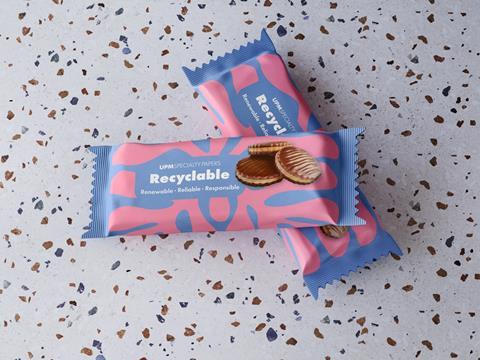
UPM Specialty Papers and Eastman have created a pack for food applications requiring grease and oxygen barriers that has a compostable, biopolymer coating.
The solution integrates Eastman’s biobased and compostable Solus performance additives with BioPBS polymer to form a thin coating onto UPM’s compostable and recyclable barrier base papers.
Due to the thinness of the coating layer, the companies say that the solution is “designed for recycling” within existing fibre recycling streams.
“We are excited to introduce the result of our development work with Eastman. Together with our partners, we are constantly pushing the performance of fibre-based packaging. This new biopolymer coated solution, for example, provides a new option for difficult-to-pack foods ranging from confectionary end-uses to meat pies found in chilled-food aisles,” says Esa Saukkonen, Manager, Packaging Portfolio Development at UPM R&D.
This solution amplifies the barrier-boosting effect of UPM Solide Lucent and UPM Prego, barrier base papers. UPM says that it offers “exceptional” heat sealability while maintaining barrier protection when folded, making it suitable for flexible packaging.
Furthermore, this technology is reportedly compatible with conventional LDPE (low-density polyethylene) extrusion coating equipment.
Traditionally, the challenge of combining extrusion coating with paper lies in the adhesion of the coating to the paper, especially with biobased or biodegradable extrusion coatings. UPM and Eastman believe that this new solution helps resolve this issue.
“Through our collaboration with UPM, we’ve developed versatile fibre-based packaging solutions that are compostable and smoothly integrate with extrusion coating equipment. Eastman Solus additive reduces coating thickness, which lowers plastic usage and enables recyclability of food packaging. These additives have been pivotal in advancing scalable, sustainable paper packaging for brands,” said Bhuma Rajagopalan, Marketing Manager, CASE Innovation at Eastman.
The packaging solution has been validated for recyclability according to the PTS method (PTS-RH 021/97 cat II) and individual components of the solution have been validated for both home and industrial compostability.
If you liked this story, you might also enjoy:
The ultimate guide to the Packaging and Packaging Waste Regulation in 2024
How are the top brands progressing on packaging sustainability?
Sustainable Innovation Report 2024: Current trends and future priorities
Everything you need to know about global plastic sustainability regulation
















No comments yet